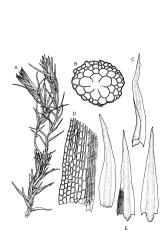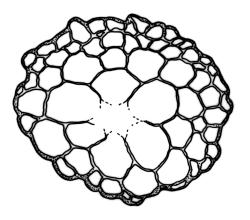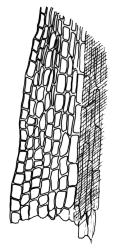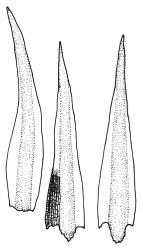Plants forming turves, dark green or dark brown below, apparently sometimes yellow-green above (living material not seen). Stems to 18 mm, much branched, often with a distinctly zig-zag appearance, the branches often arising from old perichaetia in clusters of 2–4. Leaves of lower stem triangular-lanceolate, appearing rigid, c. 1.0–1.2 × 0.25–0.3 mm, erect-spreading; mid laminal cells firm-walled and oblong-rectangular, smooth, c. 24–39 × 9–12 µm, those in the basal corners gradually becoming short-rectangular or quadrate, c. 10–15 × 12 µm and extending up the leaf margins in 2–4 rows; costa stout, occupying ⅓ or more of leaf base, percurrent or ± filling the upper ⅓ of leaf and short excurrent, in cross-section lacking stereids or other differentiated cells; leaves of innovations sometimes longer (c. 1.4–1.5 mm) and more wide-spreading.
Perichaetial leaves c. 1.2 × 0.25 mm, triangular-lanceolate or lanceolate from a ± ovate base, plane or weakly recurved, entire. Perigonia not seen. Capsules unknown.
Snider 1975, figs 200–205, 347.
Unfortunately known only from non-fruiting material, this species is exceedingly inconspicuous and possibly overlooked at other coastal sites. It is best recognised by its formation of numerous innovative branches, the zig-zag appearance of its stems, its ± wide-spreading, strongly costate leaves, and its occurrence on coastal rocks. Under the microscope, the numerous short-rectangular or quadrate cells at the basal margins, extending some distance up the lower margins, are among its most distinctive features. Strips of stem cortical cells typically adhere to the costal base when leaves are removed. The large and thin-walled central cells of the stem cross-section also facilitate its recognition. In one of the Moturoa specimens (R. Beever, 23 Jan. 1990, CHR 462057) stem cross-sections appear to show a weak tendency to form a central strand, but this does not appear to be the case in other collections.
In the type collection the leaves of the innovations are longer (c. 1.4–1.5 mm) and more wide-spreading than those of the lower stems, while in the Moturoa, Crater Rim, and Ōtauwae collections the "innovations" are not associated with perichaetia and have leaves equal to or somewhat smaller than the lower stems.
NI: N Auckland (Ahipara, Moturoa I. and associated Black Rocks); Ch (Ōtauwae Covenant).
Endemic.
On coastal rocks, especially basalt. At Black Rocks the best documented collections came from damp or waterlogged depressions on an exposed basalt platform on the Northwest Crater Rim (one of the Black Rocks), where it was associated with Campylopus introflexus and Ceratodon purpureus and the flowering plants Disphyma australe and Astelia banksii. At the Ōtauwae Covenant site this species (fide P.J. de Lange) was a "dark brown wispy moss" growing "extremely exposed to southerly storms". It grew "amongst basalt cobbles, saprolite, and on the margins of semi-permanent pools within [the] drip zone [of a] steep overhanging basalt bluff".
Archidium elatum is one of least known mosses in the New Zealand flora. The type collection from Ahipara was made in 1931. At Ahipara "most of the likely habitat is now invaded by kikuyu grass [Pennisetum clandestinum] and it is possible [that A. elatum] is no longer present at the type locality" (J.E. Beever, pers. comm., Oct. 1994). The Moturoa Is and Northwest Crater Rim collections from the Bay of Islands were made in 1990 by J.E. Beever and R. Beever (four collections in total). A single, well-documented collection from the Ōtauwae Covenant ("toward Ōtauwae Point") on Chatham I. was made by P.J. de Lange in 2006. While it is impossible to know whether A. elatum was more common in the past, reduction in its range and habitat since its original discovery is likely.
Archidium elatum is listed as a "nationally vulnerable" and "data poor" species in the 2010 edition of the N.Z. Department of Conservation’s bryophyte species threat classification ranking (Glenny et al. 2011).









